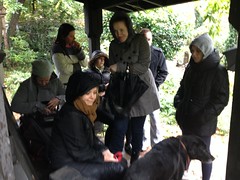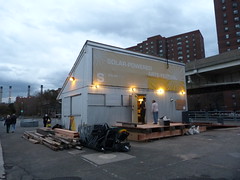6BC, a community garden located on East Sixth Street between avenues B and C, has been running solely on solar power since 1994. After Hurricane Sandy plunged the neighborhood into darkness, the garden’s six solar panels, used mostly to power weed whackers and a small ornamental waterfall, found use elsewhere.
“Everyone was dying for some news,” said Karen Tighe-Izzo, president of the garden’s board of directors. “We went in there and plugged in to listen to Bloomberg’s speech.”
Nick McKinney, a member who lives across the street from the garden, entered 6BC the morning after the hurricane to assess any damage. “I was fussing around the garden, and suddenly I realized that we not only have a solar system, but we also have an inverter,” Mr. McKinney said. That meant that the direct current power produced by the solar panels could be converted into alternating current power — the standard electrical current used by electronic devices.
Eventually, members of the garden and the community at large filtered in to charge their cell phones and listen to the news.
“It was a very happy realization, given the circumstances,” Mr. McKinney said, adding, “It’s the small pleasures in life.”
Members of the East Village garden weren’t the only ones who found solace from the storm’s wrath in the form of solar energy.
Solar One, a green energy education center located just north of Stuy Town, has teamed up with SolarCity and Consolidated Solar in recent weeks to deliver mobile solar-powered units to those in need.
The relief effort, also known as the Solar Sandy Project, has been responsible for deploying five of the 10-kilowatt units to parts of the Rockaways, with plans to mobilize units to parts of New Jersey that are without power.
Chris Collins, the executive director of Solar One, is no stranger to the power of sunlight. When he returned to the offices two days after the storm, he flicked on the building’s 3-kilowatt solar ray.
The panel, which is made up of photovoltaic cells, converts sunlight into current. Any excess energy is redirected into a back-up battery.
“It was pretty amazing,” he said. “we had the lights on and we had all of Stuy Town behind us in darkness.”
In the following days, Mr. Collins and his colleagues set up two tents outside their offices with extension cords to share their solar wealth. He estimated that 50 people showed up to charge their phones and small appliances.
“One kid even charged his nebulizer for his asthma,” he said.
Referring to the power, he said, “It never ran out. We had fairly good sunlight in the next days, and so the solar rays started getting charged again.”
Mr. Collins hopes the experience set a precedent. “The whole discussion of climate change and renewable energy, I think it’s back on the table,” he said. “People all realize that we have to take a look at our infrastructure and alternative energy needs to be a part of that,” he said.





